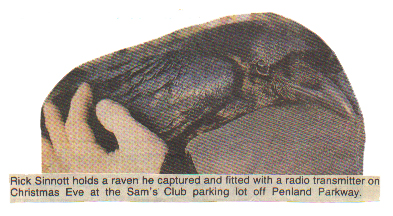 Marshall
Cultural Atlas Marshall
Cultural Atlas
This collection of student work is from
Frank Keim's classes. He has wanted to share these works for others
to use as an example of Culturally-based curriculum and documentation. These
documents have been OCR-scanned. These are available
for educational use only.
Ravens: Not Easy To
Catch
Rick Sinnott slides open the van side
door, squats on the floor and lifts the cannon into
position.
"This is like a drive-by shooting," he says under his breath.
Suddenly, there's a blast that sounds
like a rifle shot. Four steel cylinders fly outward from the cannon.
The cylinders are attached to a 12-foot net, which lands about 25
feet from the van.
The target flies to the nearest
tree.
"Dang it!" Sinnott shouts as he jumps
out of the van to collect the net. "Five feet closer we could have
gotten it."
It's not easy catching a bird as wily
as the raven.
Sinnott works all day trying to
capture ravens. He's been at it more than a month and has grabbed 39
so far. He wants 60 total. When he catches them, he tags them and
straps tiny radio transmitters on their backs.
Sinnott, a wildlife biologist with
the state Department of Fish and Game, is spending $39,000 of U.S.
Defense Department money to study the habits of Fort Richardson's
ravens.
Scientists rarely get funds to study
an animal like ravens that aren't endangered or hunted, Sinnott says.
So when the Pentagon gave Fort Richardson $69,000 to conduct a board
survey of the animal and plant population on post, he urged military
officials to spend part of that money on ravens. For years, he's been
curious about ravens, which are popular with the public but an enigma
to scientists. To his surprise, the military agreed.
"We've counted every darn moose on
base," says Bill Gossweiler, chief of the natural resources branch at
Fort Richardson. "But we don't know much about ravens, other than we
have quite a few of them."
Sinnott says scientists don't even
know the basics about ravens, such as, Where exactly do they sleep at
night? Where do they nest? How many are there in the city? Where do
they go in the summer?
Before you track ravens, though,
you've got to catch them. This is no easy task when it comes to
ravens, the brains of the bird world.
First, Sinnott tried building a huge
chicken-wire trap, 25 by 30 feet wide and 7 feet tall. He baited the
trap with moose meat for 10 days to get the ravens used to
it.
Although they weren't flying into the
trap, he continued with the scheme. Coached by a visiting raven
expert from Maine, Sinnott tied a wire to the metal pole that propped
open the trap door. He then waited behind a snowbank 300 feet
away.
Sinnott hoped to pull his end of the
wire and capture maybe 30 ravens at one time. He and the raven expert
waited two days, but unlike the ravens in rural Maine, which were
easily fooled by this kind of trap, the Anchorage ravens wouldn't go
in.
One time, when two ravens flew into
the trap, Sinnott pulled the wire, but the pole had frozen to the
ground and wouldn't budge. By the time Sinnott got the door to close,
the ravens had escaped.
Sinnott figures that Anchorage ravens
are better fed than their Maine cousins and don't take any
unnecessary risks.
Next, Sinnott tried leg traps, the
kind used for small mammals except with edges covered in rubber so
they wouldn't break the ravens' legs. He baited the traps with an
orange, cheese-flavored food product that ravens find irresistible
Cheetos.
However, these traps need to be
covered with snow, and ravens like hanging out in places without much
snow, like parking lots.
When Sinnott placed a trap in a
parking lot and covered it with snow, the ravens wouldn't touch the bait.
Sinnott then threw some Cheetos on
the pavement near the parking lot edge, and also sprinkled a few on a
snowbank where he had buried the trap.
That worked a few times, but the
ravens quickly learned to avoid Cheetos near snowbanks.
"They know those Cheetos are bad
news," he says. "They'll watch them for hours. When they get real
suspicious, they all leave the area as soon as I throw Cheetos on the
ground."
Sinnott also uses peanuts, dog food
and french fries for bait. But mindful of the ravens' logical
abilities, he tries not to do anything unusual. For example, he won't
put Cheetos in front of a McDonald's or french fries in a church
parking lot.
"It's a real personal thing between
them and me," he says. "It's the way they look at me. I can sometimes
see the wheels tuming inside their heads. They look at the pile of
snow and then look at me, and they're thinking, 'now I don't want to
eat those Cheetos right now.' "
"Sometimes I get a bigger kick
watching them avoid being caught than actually catching
them."
Sinnott has caught most of the ravens
with a net cannon. He shoots from a van because ravens are less
afraid of vehicles than people.
The transient ravens probably don't
stick to Fort Richardson's 60,000 acres, and neither does Sinnott.
When he gave up on the idea of catching a whole flock of ravens at
one time at Fort Richardson, he decided to nab ravens from all over
town. He's caught ravens in the parking areas of the Anchorage
International Airport, the Northway Mall and Carrs
Huffman.
When he's raven hunting, Sinnott
wears sound-deadening ear muffs to protect his hearing from the
cannon, and thick gloves to protect his fingers from the
ravens.
When he catches a raven, he and his
assistant quickly retrieve the net so none of the other ravens sees
it.
"The thing is," Sinnott says, "every
time you mess with one of these guys, that's just that many more
ravens who know what you're up to."
Sinnott estimates as many as 2,000
ravens fly to Anchorage every winter to feed on our refuse. He thinks
they may summer around Prince William Sound, the Mat-Su valleys, and
the Kenai Peninsula.
Their long, narrow wings,
characteristic of migrating birds, allow them to travel long
distances in their search for animal carcasses, their usual food in
the wilderness.
"They're commuters," Sinnott says.
"But where is their bedroom community?"
After he catches a raven, he wraps
tape around its beak and legs. Then he slips it into a harness that
carries a radio transmitter weighing less than an ounce. Finally he
pop-rivets a plastic, numbered tag onto the skin of its wing. The
whole process takes about 30 minutes.
The transmitter will emit a signal
for two years. Sinnott plans to fly in an airplane to track the
birds. By the end of this winter, he figures he'll know where the
ravens sleep at night.
Perhaps. But not if the ravens figure
out what he's up to first.

Christmastime Tales
Stories real and imaginary about Christmas, Slavik, and the New Year
Winter, 1996 |
Christmastime Tales II
Stories about Christmas, Slavik, and the New Year
Winter, 1998 |
Christmastime Tales III
Stories about Christmas, Slavik, and the New Year
Winter, 2000 |
| Summer Time Tails 1992 |
Summertime Tails II 1993 |
Summertime Tails III |
| Summertime Tails IV Fall, 1995 |
Summertime Tails V Fall, 1996 |
Summertime Tails VI Fall, 1997 |
| Summertime Tails VII Fall, 1999 |
Signs of the Times November 1996 |
Creative Stories From Creative Imaginations |
| Mustang Mind Manglers - Stories of the Far Out,
the Frightening and the Fantastic 1993 |
Yupik Gourmet - A Book of
Recipes |
|
| M&M Monthly |
|
|
| Happy Moose Hunting! September Edition 1997 |
Happy Easter! March/April 1998 |
Merry Christmas December Edition 1997 |
| Happy Valentine’s
Day! February Edition
1998 |
Happy Easter! March/April Edition 2000 |
Happy Thanksgiving Nov. Edition, 1997 |
| Happy Halloween October 1997 Edition |
Edible and Useful Plants of Scammon
Bay |
Edible Plants of Hooper Bay 1981 |
| The Flowers of Scammon Bay Alaska |
Poems of Hooper Bay |
Scammon Bay (Upward Bound Students) |
| Family Trees and the Buzzy Lord |
It takes a Village - A guide for parents May 1997 |
People in Our Community |
| Buildings and Personalities of
Marshall |
Marshall Village PROFILE |
Qigeckalleq Pellullermeng ‘A
Glimpse of the Past’ |
| Raven’s
Stories Spring 1995 |
Bird Stories from Scammon Bay |
The Sea Around Us |
| Ellamyua - The Great Weather - Stories about the
Weather Spring 1996 |
Moose Fire - Stories and Poems about Moose November,
1998 |
Bears Bees and Bald Eagles Winter 1992-1993 |
| Fish Fire and Water - Stories about fish, global warming
and the future November, 1997 |
Wolf Fire - Stories and Poems about Wolves |
Bear Fire - Stories and Poems about Bears Spring,
1992 |
|